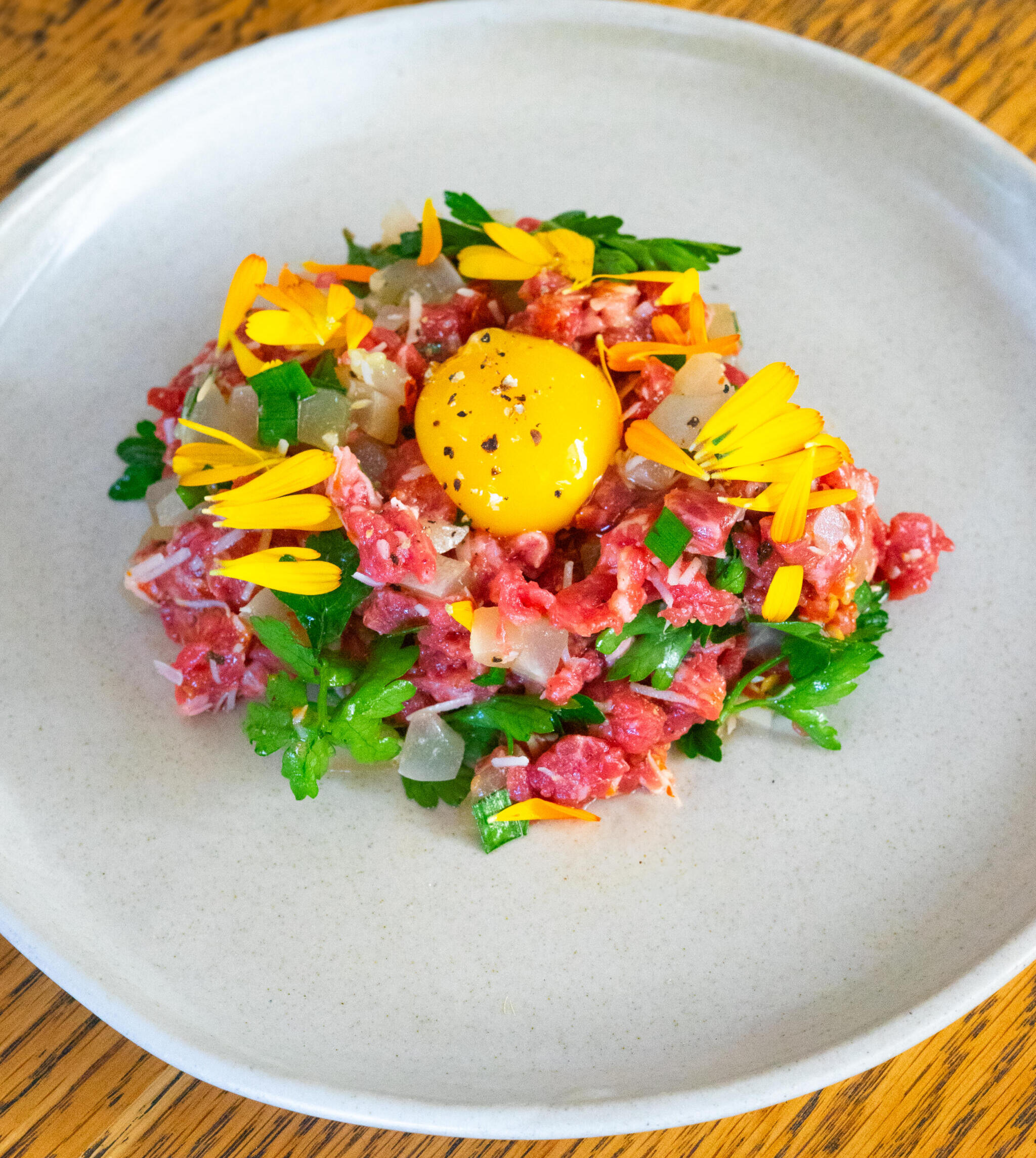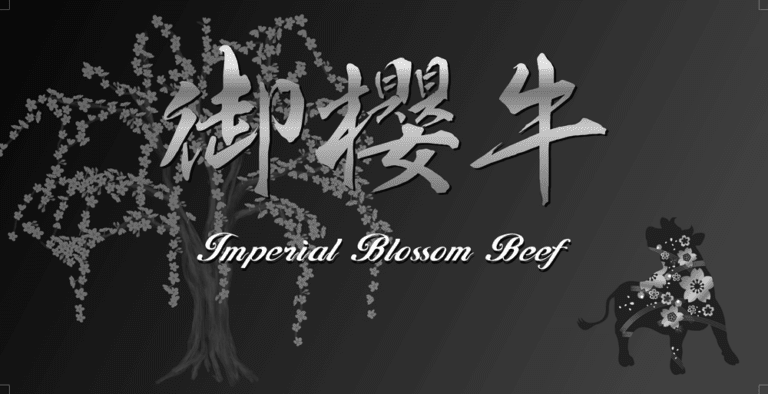
Grilled Stone Axe OP Rib, Seaweed Bearnaise, Coal Roasted Vegetables, Pepper Sauce (serves 2-4 pax)
Recipe by Shane Middleton, Head Chef of Papi Katsu Perth CBD Kombu -Jime +9 Stone Axe OP Rib 1 x

October is the perfect time to indulge in the rich flavours of wagyu beef sukiyaki at Lux Wagyu House. This exquisite dish, steeped in tradition, showcases the luxurious marbling of premium wagyu beef, making it a delightful experience for any food lover. Whether you’re a seasoned connoisseur or trying sukiyaki for the first time, the combination of tender beef and aromatic broth is sure to leave a lasting impression. Let’s explore the world of wagyu beef sukiyaki and what makes it so special.
So, what exactly is Wagyu? Well, the term “Wagyu” simply translates to “Japanese cow”. But it’s more than just any old cow from Japan. It refers to four specific breeds of Japanese cattle: Japanese Black (Kuroge), Japanese Brown (Akage), Japanese Shorthorn (Nihon Tankaku), and Japanese Polled (Mukaku). These breeds are genetically predisposed to intense marbling, which is the key to their unique flavour and tenderness. Cross-breeding these breeds with others is a no-go in Japan, ensuring the Wagyu name stays pure. It’s a bit like a pedigree for beef!
Wagyu beef is famous for its incredible marbling – those fine flecks of intramuscular fat that look like a roadmap through the meat. This marbling isn’t just for show; it’s what makes Wagyu so tender and flavourful. The fat melts at a lower temperature than other beef, giving it that melt-in-your-mouth sensation. Plus, Wagyu has a higher percentage of monounsaturated fats (the good kind!) and a distinct umami flavour. It’s a truly luxurious experience. When you’re looking for slow-cooked Wagyu beef cuts, remember that the marbling is key.
Not all Wagyu is created equal. You’ll often hear about different grades and brands, which can be a bit confusing. The Japanese Meat Grading Association sets strict standards based on yield (how much usable meat the cow produces) and quality (marbling, colour, firmness, and texture). Yield grades range from A to C, with A being the best. Quality grades go from 1 to 5, with 5 being the highest. So, an A5 Wagyu is top-of-the-line! Then you have special Wagyu varieties like Kobe Beef and Matsusaka Beef, which have even stricter criteria. It’s a whole world of beef to explore!
Think of it like this: Wagyu is the umbrella term, and under that umbrella are different breeds, grades, and brands. Each one offers a slightly different experience, but they all share that signature marbling and incredible flavour.
Here’s a quick breakdown:
Sukiyaki is more than just a meal; it’s an experience. It’s about gathering around a table, sharing stories, and enjoying the rich flavours of premium ingredients cooked in a simmering pot. Let’s explore the art of sukiyaki, from its essential components to the techniques that make it so special.
What exactly goes into a traditional sukiyaki? Well, it’s a delightful mix of textures and tastes. The star, of course, is thinly sliced beef, preferably Wagyu for its melt-in-your-mouth quality. But the supporting cast is just as important. You’ll need:
Cooking sukiyaki is a communal affair, usually done right at the table on a portable gas stove or induction cooktop. Here’s how it generally goes down:
Serving sukiyaki is all about creating a relaxed and enjoyable atmosphere. Here are a few tips:
Sukiyaki is best enjoyed slowly, savouring each bite and the company of those around you. It’s a dish that encourages conversation and connection.
If you’re looking for a premium Wagyu experience, sukiyaki is a fantastic choice. And if you’re feeling adventurous, why not try a sukiyaki recipe at home? It’s easier than you might think, and the results are incredibly rewarding.
Let’s talk about what makes dining at Lux Wagyu House a truly special occasion. It’s more than just a meal; it’s an immersive experience designed to showcase the very best of Wagyu beef. From the moment you step inside, you’re transported to a world of culinary excellence.
Lux Wagyu House prides itself on offering a private dining experience. Forget crowded dining rooms and noisy chatter. Here, you’ll find intimate, secluded spaces perfect for special occasions or a quiet, luxurious meal. The ambience is carefully curated to enhance your enjoyment of the food, with elegant decor and soft lighting creating a relaxed and sophisticated setting. It’s the kind of place where you can truly unwind and focus on the exquisite flavours in front of you.
Of course, the star of the show is the Wagyu itself. Lux Wagyu House has a range of signature dishes designed to highlight the unique qualities of this premium beef.
The chefs at Lux Wagyu House are masters of their craft, using innovative techniques to bring out the best in every cut. They understand that Wagyu is more than just beef; it’s an art form.
What truly sets Lux Wagyu House apart is its commitment to exceptional service. The staff are knowledgeable, attentive, and passionate about providing a memorable dining experience. They’re happy to guide you through the menu, explain the different cuts of Wagyu, and offer recommendations based on your preferences. From the moment you arrive until the moment you leave, you’ll be treated with the utmost care and respect. It’s this dedication to service that elevates Lux Wagyu House from a great restaurant to an unforgettable destination.
Sukiyaki isn’t just a meal; it’s a reflexion of Japanese culture and history. It’s a dish deeply embedded in the nation’s culinary traditions, often enjoyed during special occasions and gatherings. Sukiyaki represents a communal dining experience, where family and friends gather around a simmering pot, sharing stories and strengthening bonds. The dish itself showcases the Japanese appreciation for high-quality ingredients and meticulous preparation. It’s a testament to how food can be more than just sustenance; it can be a symbol of togetherness and cultural identity. What makes sukiyaki so special in Japanese cuisine? It’s the combination of premium ingredients, the interactive cooking process, and the shared experience that elevates it beyond a simple meal.
In Japan, sukiyaki is often associated with celebrations and special events. Think New Year’s Eve, birthdays, or even just a well-deserved family dinner. The act of cooking and sharing sukiyaki fosters a sense of unity and joy. It’s a dish that brings people together. The bubbling pot becomes a focal point, encouraging conversation and laughter. The premium ingredients, especially the Wagyu beef, signify the importance of the occasion. It’s a way to show appreciation and create lasting memories. Why is sukiyaki chosen for these moments? Because it’s more than just food; it’s an experience that embodies warmth, togetherness, and celebration.
Like many beloved dishes, sukiyaki has regional variations across Japan. While the core ingredients remain similar, the preparation and flavour profiles can differ significantly. For example, in the Kanto region (Tokyo), sukiyaki is typically cooked in a warishita sauce, a pre-mixed blend of soy sauce, sugar, and mirin. In contrast, the Kansai region (Osaka) often starts by grilling the beef in the pot before adding the vegetables and sauce. This grilling technique imparts a unique smoky flavour. These regional differences highlight the diversity of Japanese cuisine and the adaptability of sukiyaki to local tastes and preferences. What are some other regional twists? Some areas might include different types of vegetables, tofu, or even seafood, reflecting the local produce and culinary traditions.
Sukiyaki, with its rich, savoury broth and delicate slices of Wagyu beef, presents a unique opportunity for wine pairing. It’s not just about finding a wine that ‘goes’ with the dish; it’s about finding a wine that elevates the entire dining experience. People often ask, ‘What wine complements the sweetness of sukiyaki?’ or ‘Can I pair red wine with Wagyu?’ Let’s explore the best options.
Selecting the right wine to accompany Wagyu sukiyaki involves considering the dish’s key flavour components: the sweetness from the sukiyaki sauce (usually a blend of soy sauce, mirin, and sugar), the richness of the Wagyu beef, and the umami from the various vegetables and tofu. A wine with good acidity is essential to cut through the richness of the beef and balance the sweetness of the sauce. Consider these factors when making your choice:
Wine can truly transform your sukiyaki experience. The right wine won’t just sit alongside the dish; it will interact with the flavours, bringing out new nuances and creating a more harmonious whole. For example, a slightly chilled Beaujolais can highlight the delicate sweetness of the beef, while a dry rosé can enhance the savoury notes of the broth. Experimenting with different wines is part of the fun! Think about how the wine’s characteristics interact with the Wagyu. Does it amplify the richness, or does it provide a refreshing contrast?
So, what are some specific wines that work well with Wagyu sukiyaki? Here are a few recommendations to get you started:
Ultimately, the best wine pairing is the one you enjoy the most. Don’t be afraid to try different wines and discover your own personal preferences. Consider visiting a restaurant with a sommelier who can guide you through the options and help you find the perfect match for your Wagyu sukiyaki.
So, you’re keen to experience the magic of wagyu beef sukiyaki? Excellent choice! Finding the right spot can truly elevate the experience. Whether you’re after a traditional setting or something a bit more modern, here’s a look at some options to consider.
Ginza is basically the epicentre of high-end dining in Tokyo, and it’s brimming with restaurants that specialise in wagyu. You’ll find everything from traditional Japanese restaurants to modern steakhouses. Many places focus on A5-ranked wagyu, prepared by chefs who really know how to cook wagyu beef sukiyaki to bring out its unique flavour.
Some notable spots include:
Beyond the standard restaurant setting, there are some unique ways to enjoy wagyu sukiyaki. Think about these options:
Experiencing wagyu sukiyaki isn’t just about the food; it’s about the atmosphere, the service, and the overall cultural experience. Take your time, ask questions, and savour every moment.
Given the popularity of wagyu sukiyaki, especially in areas like Ginza, making a reservation is almost always a good idea. Many restaurants have online booking systems, and some might require a phone call, especially for private rooms or special requests. When booking, don’t hesitate to ask for recommendations on the best wagyu beef cuts for sukiyaki or any seasonal specials they might be offering.
Enjoy your wagyu sukiyaki adventure!
So, you want to make sukiyaki at home? Good on ya! First things first, you’ll need the right gear. Don’t stress, it’s not too complicated. Here’s a quick rundown:
Alright, let’s get cooking! This recipe is a great starting point, feel free to adjust it to your liking. Remember, sukiyaki is all about sharing and enjoying the process.
Choosing the right Wagyu is key to a truly amazing sukiyaki experience. Here’s what to look for:
Don’t be afraid to experiment with different ingredients and flavours. Sukiyaki is a very forgiving dish, and it’s all about having fun and creating something delicious with your mates. So gather your friends, crack open a cold one, and get ready for a sukiyaki feast!
Making the ideal sukiyaki at home is easier than you think! Start by gathering fresh ingredients like thinly sliced beef, vegetables, and tofu. The key is to create a rich, sweet sauce that brings everything together. For a step-by-step guide and to find the best ingredients, visit our website today! You’ll be enjoying a delicious homemade sukiyaki in no time!
In conclusion, if you’re keen to experience the rich flavours of traditional Japanese sukiyaki, Lux Wagyu House is a must-visit. Their commitment to quality, especially with the premium wagyu beef, truly sets them apart. Not only do you get to savour the exquisite taste of the beef, but you also immerse yourself in a piece of Japanese culture. The private dining rooms add a touch of elegance, making it perfect for special occasions or a memorable night out. So, whether you’re a wagyu aficionado or just curious about Japanese cuisine, this place offers a unique dining experience that you won’t want to miss.
Wagyu beef comes from a special breed of cattle in Japan. It is known for its amazing tenderness and rich flavour due to its unique fat marbling.
Sukiyaki is a traditional Japanese hot pot dish. It features thin slices of beef cooked in a sweet soy sauce broth with vegetables, making it a delicious and comforting meal.
For Sukiyaki, Wagyu beef is usually sliced very thin. This helps it cook quickly and ensures it stays tender and juicy.
Yes! You can make Sukiyaki at home. You’ll need some basic ingredients like beef, vegetables, and a sweet soy sauce broth. It’s a fun dish to prepare with family or friends.
The best cuts for Sukiyaki are usually ribeye or sirloin. These cuts have great marbling, which adds flavour and tenderness when cooked.
You can find amazing Sukiyaki in many restaurants, especially in areas like Ginza. Look for places that specialise in Wagyu beef for the best experience.

Recipe by Shane Middleton, Head Chef of Papi Katsu Perth CBD Kombu -Jime +9 Stone Axe OP Rib 1 x

Recipe by Guy Jeffreys, Ambassador of Fogarty Wine Group and Kitchen Community Ingredients: 150g Lotte L’Grow Oyster Blade (MB 8






